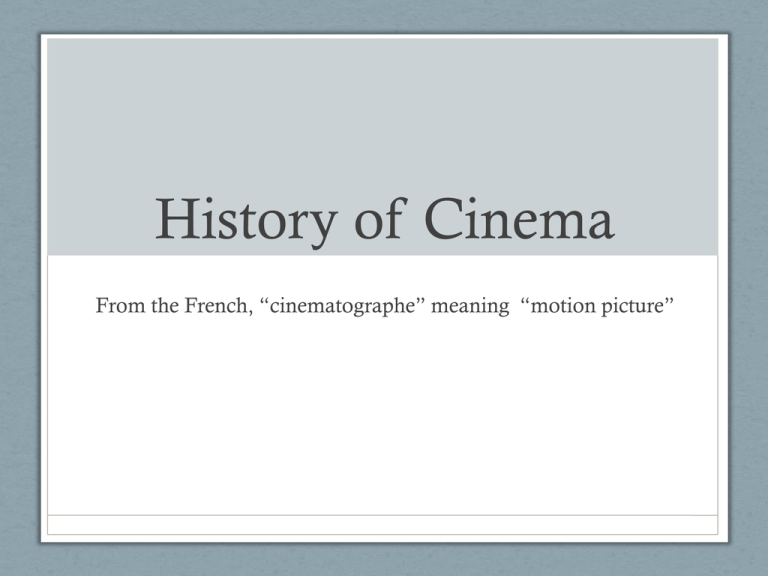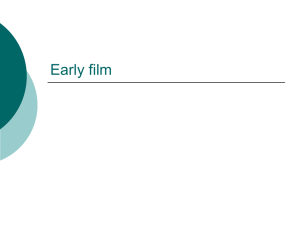History of Cinema
advertisement

History of Cinema From the French, “cinematographe” meaning “motion picture” Early Years • 17th -18th century: Lantern slides • 19th century saw vast proliferation of visual forms of popular culture • Industrial Era • Books of photographs, illustrated fiction Early Years • Middle/working class: • Visit circuses, amusement parks, music halls, theater troupes, dioramas, stereoscopes Diorama • Painted backdrops featuring 3-D figures depicting historical events Stereoscopes • Hand-held viewers that created three dimensional effects by using oblong cards with two photographs printed side by side Pre-conditions for Motion Pictures • 1st: Scientists had to realize, the human eye will perceive motion if a series of slightly different images is placed before it in rapid successionminimally around 16 per second. Phenakistoscope (1832) • Deceiving scope • http://www.youtube.com/watch?v=94OHrt755QU Zoetrope (1833) • Life + turn • http://www.youtube.com/watch?v=-3yarT_h2ws Pre-conditions for Motion Pictures • 2nd: these fast-moving images needed to be projected on a surface • 17th Century “magic lanterns” projecting glass lantern slides (paintings illuminated by glass), but couldn’t flash large numbers of images fast enough to create illusion of motion. Pre-conditions for Motion Pictures • 3rd: Ability to use photography to make successive pictures on clear surface • Speed up exposure time Exposure • the act of presenting rays of light to a photosensitive surface. • First photograph/frame had exposure time of 8 hours (1839) • Motion pictures=split-second exposure • This became feasible in 1878 Pre-conditions for Motion Pictures • 4th: Photographs needed to be printed on a base flexible enough to be passed through a camera rapidly. • 1888: George Eastman devised a camera that made photographs on rolls of thin paper. Kodak! • The next year, he introduced transparent roll of film creating a breakthrough in the move toward cinema. Pre-conditions of Motion Picture • 5th: Needed to find a suitable mechanism for cameras and projectors. • The camera: the film strip had to stop briefly while light entered through the lens and exposed each frame; a shutter then covered the film as another frame moved into place. Shutter • a mechanical device for opening and closing the aperture of a camera lens to expose film or the like. Aperture • an opening, usually circular, that limits the quantity of light that can enter an optical instrument. Major Pre-cursors of Motion Picture • Eadward Muybridge (1878) and the running horses •Photographer •Row of 12 cameras, each making an exposure in one-thousandth of a Second. •Lantern to project the images which were eventually drawings copied from the photographs onto a revolving disk https://www.youtube.com/watch?v=FYKZif9ooxs Invention of the Motion Picture • Thomas Edison developed Kinetoscope in 1891 the first motion picture system (peep show in a box) • Scottish-English immigrant William Dixson joined Edison’s team to help develop the technology that would combine pictures and sound • Looped in :30 vignettes, no story connecting them Kinetoscope • A phonograph inside the cabinet. The viewer would look into the peep-holes of the Kinetoscope to watch the motion picture while listening to the accompanying phonograph through two rubber ear tubes connected to the machine. The picture and sound were made somewhat synchronous by connecting the two with a belt • 46 frames per second Kinetoscope The Bioscop • Invented by Skladanowsky brothers • Held two strips of 3 ½” film running side by sideframes projected alternately • 15 minute programs • Too cumbersome The Bioscop The Lumiere Brothers • Invented a projection system that helped make cinema a commercially viable enterprise internationally!! • Designed the “cinematographe” • 35 mm film • 16 frames per second Lumiere Brothers • Workers Leaving the Factory, 1895 American Developments • Edison’s Kinetoscope evolved into Vitascope (life scope) October 1895 • https://www.youtube.com/watch?v=L7HJAohiuuo • Inventor, Thomas Armat created Vitascope and Edison manufactured it. • 1894: American Mutoscope Company • 70 mm film that yielded larger, sharper images American Developments • 1905- Admission to Nickelodeon (movie theater) = $.05-$.10 for a 15-60 minute production • Audiences sat on benches, wooden seats • Front display=hand painted signs • Actors stood behind screen and spoke dialogue in synchronization with the action on the screen • Sound effects were made with noisemakers behind the screen • Warner Bros., Universal, Paramount, MGM got there start as Nickelodeon exhibitors Nickelodeon Production • The whole creative process involved in the making of a film (shooting footage, set design, costume, directing, editing, etc) Distribution • The process of selling and marketing the film Exhibition • The process of showing the film in theaters • Exhibitors were those who owned and operated theaters and were involved in the buying/renting process of films.





